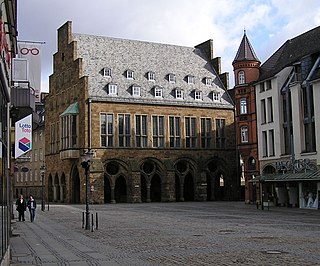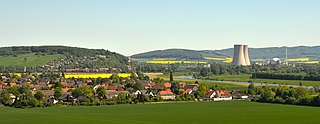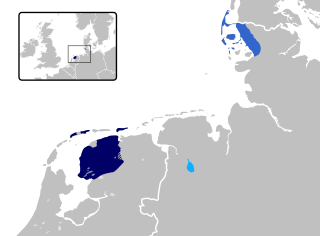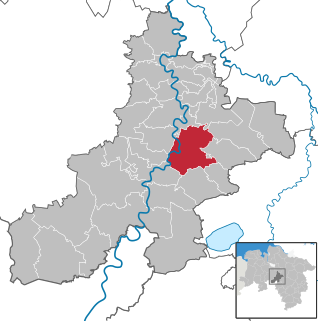A list of rivers of the state Bremen , Germany:
Contents
| Wikimedia Commons has media related to Rivers of Bremen (state) . |
A list of rivers of the state Bremen , Germany:
| Wikimedia Commons has media related to Rivers of Bremen (state) . |

Lower Saxony is a German state (Land) situated in northwestern Germany. It is the second-largest state by land area, with 47,624 km2 (18,388 sq mi), and fourth-largest in population among the 16 Länder federated as the Federal Republic of Germany. In rural areas, Northern Low Saxon and Saterland Frisian are still spoken, in declining numbers.

The Weser is a river of Lower Saxony in north-west Germany. It begins at Hannoversch Münden through the confluence of the Werra and Fulda. It passes through the Hanseatic city of Bremen. Its mouth is 50 km (31 mi) further north against the ports of Bremerhaven and Nordenham. The latter is on the Butjadingen Peninsula. It then merges into the North Sea via two highly saline, estuarine mouths.

The Werra, a river in central Germany, is the right-bank headwater of the Weser. Weser is a synonym in an old dialect of German. The Werra has its source near Eisfeld in southern Thuringia. After 293 kilometres (182 mi) the Werra joins the river Fulda in the town of Hann. Münden, forming the Weser.

Aktien-Gesellschaft „Weser" was one of the major German shipbuilding companies, located at the Weser River in Bremen. Founded in 1872 it was finally closed in 1983. All together, A.G. „Weser" built about 1,400 ships of different types, including many warships. A.G. „Weser" was the leading company in the Deutsche Schiff- und Maschinenbau AG, a cooperation of eight German shipbuilding companies between 1926 and 1945.

Minden is a town of about 81,000 inhabitants in the north-east of North Rhine-Westphalia, Germany. The town extends along both sides of the River Weser. It is the capital of the district (Kreis) of Minden-Lübbecke, which is part of the region of Detmold. Minden is the historic political centre of the cultural region of Minden Land. It is widely known as the intersection of the Mittelland Canal and the River Weser. The town is over 1,200 years old and retains some buildings in the Weser Renaissance style, in addition to its architecturally symbolic 1,000-year-old cathedral.

The Weser Uplands is a hill region in Germany, between Hannoversch Münden and Porta Westfalica, along the river Weser. The area reaches into three states, Lower Saxony, Hesse, and North Rhine-Westphalia. Important towns of this region include Bad Karlshafen, Holzminden, Höxter, Bodenwerder, Hameln, Rinteln, and Vlotho.

East Frisian is one of the Frisian languages. Its last surviving dialect is spoken in Saterland in Germany.

Nienburg is a town and capital of the district Nienburg, in Lower Saxony, Germany.

The Dulgubnii are a Germanic tribe mentioned in Tacitus' Germania as living in what is today northwest Germany. Tacitus describes them being to the north of the Angrivarii and Chamavi, and as having moved from the north into the area once belonging to the Bructeri, between Ems, Lippe, and Weser. In this same area as the Dulgubnii, north of the Chamavi and Angrivarii, were the Chasuarii, and north of these, on the North Sea coast, where the Chauci. The Chasuarii's name is thought to derive from the River Hase which feeds into the middle of the Ems from the east, just northwest of the area associated with the Angrivarii, on the Weser. So from Tacitus, it appears that the Dulgubnii probably lived near the Weser.

Vegesack is a northern district of the city of Bremen.

Weserstadion is a multi-purpose stadium in Bremen, Germany. The Weserstadion is scenically situated on the north bank of the Weser River and is surrounded by lush green parks. The city center is only about a kilometre away. It is the home stadium of German Bundesliga 2 club Werder Bremen.

Deutsche Schiff- und Maschinenbau Aktiengesellschaft was a cooperation of eight German shipyards in the period 1926 to 1945. The leading company was the shipyard AG Weser in Bremen.

Bremen, officially the City Municipality of Bremen, is the capital of the German state Free Hanseatic City of Bremen, a two-city-state consisting of the cities of Bremen and Bremerhaven. With about 570,000 inhabitants, the Hanseatic city is the 11th largest city of Germany and the second largest city in Northern Germany after Hamburg.

Weser-Rhine Germanic is a term introduced by the German linguist Friedrich Maurer for the group of prehistoric West Germanic dialects ancestral to Dutch and to the West Central German dialects. It is a replacement for the older term Istvaeonic, with which it is essentially synonymous. The term Rhine-Weser-Germanic is sometimes preferred.

The Main–Weser Railway is a railway line in central Germany that runs from Frankfurt am Main via Gießen to Kassel. it is named after the railway company that built the line and also operated it until 1880. It was opened between 1849 and 1852 and was one of the first railways in Germany.

Erich Koch-Weser was a German lawyer and liberal politician. One of the founders (1918) and later chairman (1924–1930) of the liberal German Democratic Party, he served as minister of the Interior (1919–1921), vice-chancellor of Germany (1920) and minister of Justice (1928–1929).

Weser Renaissance is a form of Northern Renaissance architectural style that is found in the area around the River Weser in central Germany and which has been well preserved in the towns and cities of the region.

JadeWeser Airport is an minor unscheduled airport near Wilhelmshaven, Lower Saxony, Germany. It is located near JadeWeserPort, a major German deep-sea harbour construction site.

Sarah Janina Ryglewski is a German politician of the Social Democratic Party (SPD) who has been serving as a member of the Bundestag from the state of Bremen since 2015.